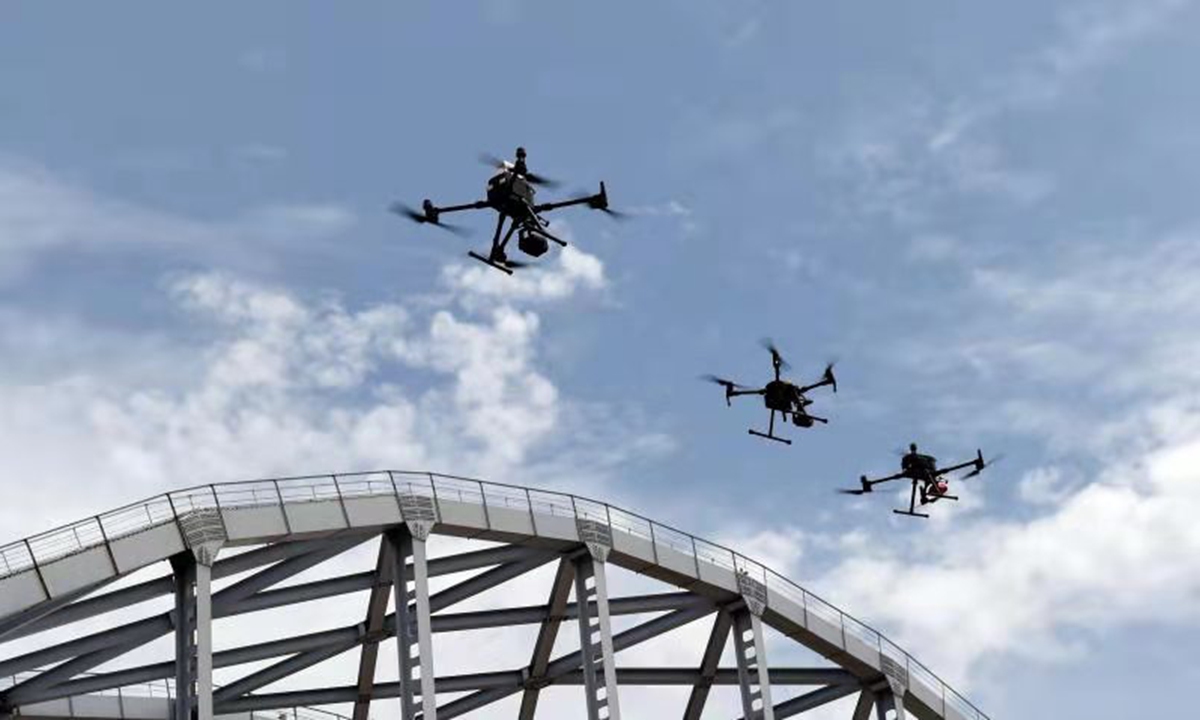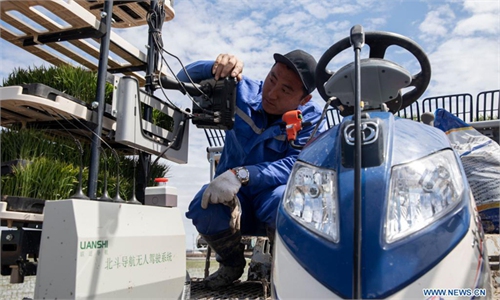GT on spot: Beidou-, 5G-based UAVs patrol high-speed railway for 1st time to ensure passenger safety

Three UAVs equipped with a high precision equipment patrol around the Jinan Yellow River Bridge to inspect its steel structure.
On Wednesday, as the Beijing-Shanghai high-speed trains roared past through the Jinan Yellow River Bridge, East China's Shandong Province, a Global Times reporter noticed that under the bridge there were three unmanned aerial vehicles (UAVs) equipped with a high precision equipment patrolling around the bridge to inspect its steel structure.
This is the first time that the autonomous UAV intelligent railway inspection system, which is based on 5G technology and the BeiDou Navigation Satellite System (BDS), has been applied domestically and internationally.
As the largest and busiest high-speed rail line in China, the Beijing-Shanghai high-speed railway has adopted many modern high-tech measures to ensure passenger safety.
Yang Huaizhi, director of equipment safety department at Beijing-Shanghai High-Speed Railway Co, said the system mainly consists of fixed- or mobile-landing platforms, UAVs, a variety of special detection and automatic control instruments and intelligent backstage systems.
Photos, videos and other detection data taken by UAVs are automatically sent back to the control center. In the control center, the background software uses intelligent analysis to inspect changes in photos, videos and other data, identify abnormal changes, and automatically issue out warning of risks.
Over the past 10 years since its opening, the Beijing-Shanghai high-speed railway has transported more than 1.35 billion passengers safely. With a total travel distance of more than 1.58 billion kilometers, equivalent to nearly 40,000 times around the equator.
For high-speed railways with extremely high operating density, such as Beijing-Shanghai high-speed railway, human workers only have four hours for on-line inspection from 00:30 to 4:30 am, a limited time considering the amount of work they have to do. Meanwhile, due to its height, it is also difficult to investigate and do large-scale inspections. But the new system has come to their rescue.
The new high-tech system, on the premise of flight safety, achieved the 24-hour inspection after nearly two years of development and testing. The system has now entered the stage of trial application and promotion.
Yang said the system can cover 1,318 kilometers of automatic inspection on the entire Beijing-Shanghai high-speed railway.
When selecting equipment, the system can choose two kinds of UAVs. One is the rotary-wing UAV, which is used for patrol inspection with high accuracy requirements. It can hover to adjust the angle and zoom for positioning shooting and accurate reshooting, its accuracy can reach centimeter or even millimeter level. The other is a fixed-wing UAV, which is used to patrol in large areas. The fixed-wing UAV can fly higher, travel faster and cover large areas.
The automatic control and multi-function detection instruments carried by the UAVs are specially-developed, mini- and high-precision devices. They are also equipped with infrared night vision auxiliary system and laser radar instruments.
When asked whether the UAVs have any security risks when patrolling, Yang said that the top priority in developing the system was to ensure the safety of drone flights and making sure that the patrol would not affect the normal operation of high-speed trains.
"Through precise positioning based on BDS and other technical means, the no-fly zone of the electronic fence is set directly above and on both sides of the railway, which means that the UAVs cannot fly inside the electronic fence, and the operation safety of the railway is guaranteed," Yang noted.


